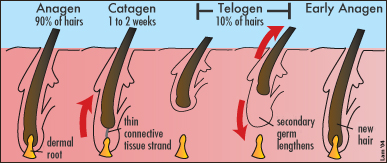Hair Loss Cycle Dallas
 Understanding hair loss cycles and growth cycles will be helpful in the fundamental understanding of the patterns, or hair-loss cycles, which can serve as a useful background for anyone interested in hair restoration.
Understanding hair loss cycles and growth cycles will be helpful in the fundamental understanding of the patterns, or hair-loss cycles, which can serve as a useful background for anyone interested in hair restoration.
Human Hair loss and Growth Cycle
Scalp hair only constitutes a small fraction (100,000 to 150,000 follicles) of the total count for the body (approximately 5 million follicles). Hair growth can be divided into three distinct phases: anagen (active growth), catagen (active loss), and telogen (resting). In the nonbalding scalp, 90% of hairs remain in the active growth, or anagen phase, which extends over a period of 3 years. During the catagen phase that lasts about 2 to 3 weeks, the hair separates from the dermal root but remains in place only by a thin strand of connective tissue. Telogen, or resting, phase, follows in which the basal attachment becomes even more attenuated, resulting ultimately in the hair shaft falling out. Normally, nonbalding hair remains in the telogen phase about 10% of the time, and the phase lasts about 3 to 4 months. When the rate of hair loss exceeds that of hair growth, thinning of hair ensues.
 In addition to actual hair loss, male pattern baldness is characterized by the conversion of terminal (thick and healthy) hair into vellus (thin and fine) “baby” hair. The controlling factor for hair loss is derived from a single, autosomal gene that is regulated by circulating levels of androgens (male hormones that consist of testosterone and dihydrotestosterone). With the onset of puberty for men, the surge in androgens drives the alteration from terminal to vellus hair and the beginning of hair loss. The ongoing rate of hair loss and change to vellus hair is contingent principally upon genetic forces.
In addition to actual hair loss, male pattern baldness is characterized by the conversion of terminal (thick and healthy) hair into vellus (thin and fine) “baby” hair. The controlling factor for hair loss is derived from a single, autosomal gene that is regulated by circulating levels of androgens (male hormones that consist of testosterone and dihydrotestosterone). With the onset of puberty for men, the surge in androgens drives the alteration from terminal to vellus hair and the beginning of hair loss. The ongoing rate of hair loss and change to vellus hair is contingent principally upon genetic forces.
Both male hormones (testosterone and dihydrotestosterone) are found to varying degrees in men and women. Testosterone is necessary for beard, axillary (underarm), and pubic hair growth but does not affect scalp hair. The presence of dihydrotestosterone, on the other hand, can lead to hair loss in hairs that are destined for hair loss but will not affect other non-susceptible hairs. For men, susceptible hairs are distributed over the front and top of the head but the sides and back of the head are resistant to such loss. Even in the baldest individual, there is still an abundance of hair in the back and sides of the head: these areas serve as donor hair for transplantation to areas that are bald. In fact, hair from the temple and back of the head transplanted to other areas will never undergo loss, as they are genetically programmed to remain forever. This fact serves as the underlying principle for modern hair restoration.




